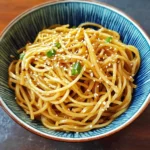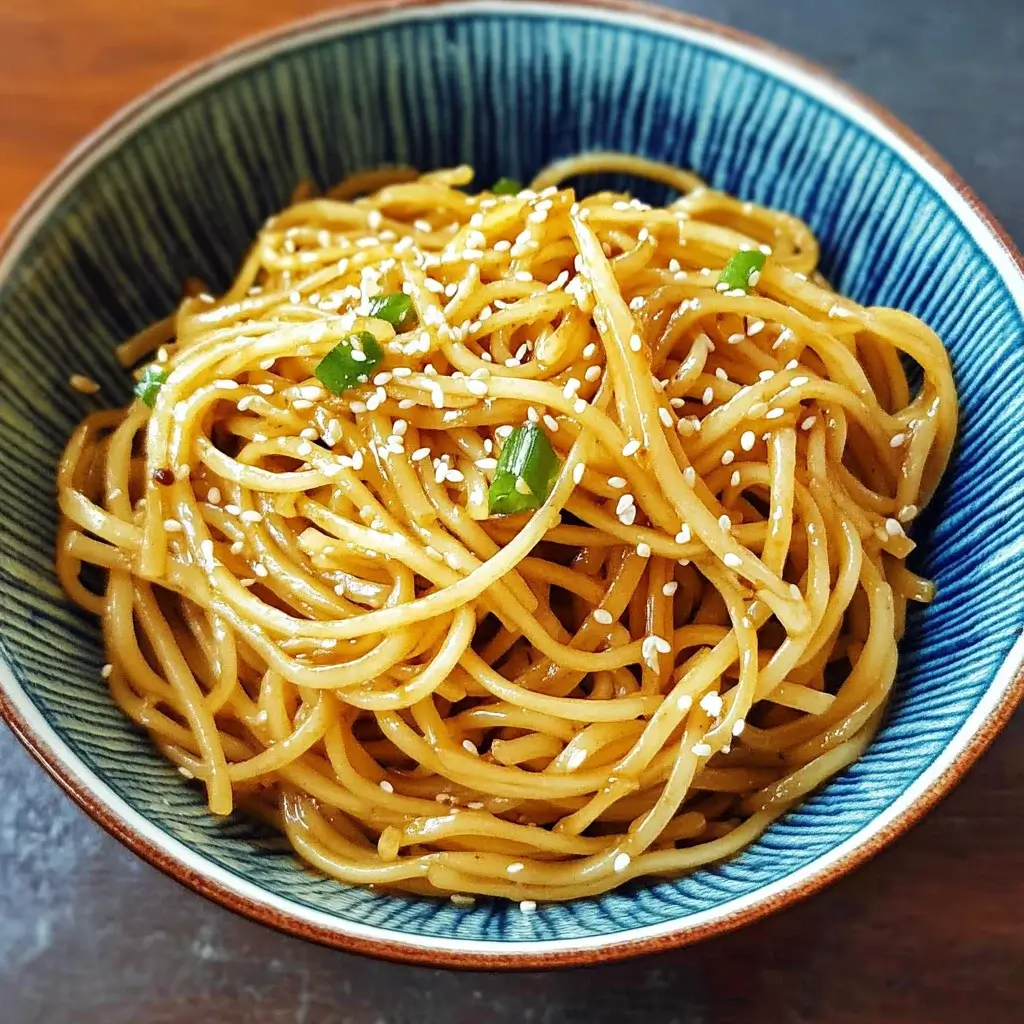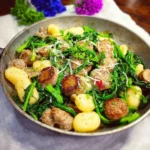Life gets busy, and sometimes the last thing you want to do after a long day is spend hours in the kitchen. That’s where these Quick Asian Sesame Garlic Noodles come to the rescue. This recipe has become my absolute go-to for those evenings when hunger strikes fast and the pantry is looking a little bare. Honestly, I threw this together on a whim one night, using ingredients I almost always have on hand, and the result was so incredibly delicious and satisfying that it’s now a weekly staple. The kids love it (even the picky eater!), it’s ready in minutes, and the flavor is just… wow. The savory sesame garlic sauce coats every strand of noodle perfectly, creating a dish that’s both comforting and bursting with Asian-inspired flavors. If you’re craving a quick, flavorful, and fuss-free meal, look no further. These Quick Asian Sesame Garlic Noodles are about to become your new best friend in the kitchen.
Ingredients: Your Pantry Essentials for Sesame Garlic Noodle Magic
The beauty of these Quick Asian Sesame Garlic Noodles lies in their simplicity. You likely already have most of these pantry staples on hand. Let’s break down each ingredient, highlighting its role and offering potential substitutions to ensure you can whip up this dish no matter what your kitchen looks like.
For the Star of the Show: The Noodles
- 1 pound Noodles (Spaghetti, Linguine, Udon, or Ramen): The foundation of our dish! The versatility of this recipe means you can use a variety of noodles depending on your preference and what you have available.
- Spaghetti or Linguine: These long, thin pasta shapes are classic choices and work beautifully with sesame garlic sauce. They are readily available and cook quickly. Whole wheat versions can also be used for a slightly healthier option, but may have a firmer texture.
- Udon Noodles: Thick, chewy, and satisfying, udon noodles bring a wonderful texture to this dish. Pre-cooked udon noodles are incredibly convenient and cook in just minutes. Look for them in the refrigerated or frozen section of your grocery store.
- Ramen Noodles (fresh or dried): While often associated with soup, ramen noodles are fantastic pan-fried or tossed in sauces. Discard the seasoning packets that come with instant ramen and cook the noodles separately. Fresh ramen noodles offer a superior texture but dried ramen is a budget-friendly pantry staple.
- Lo Mein Noodles: Similar to spaghetti but often slightly thicker and made with eggs, lo mein noodles are another excellent choice if you can find them.
- Gluten-Free Options: For a gluten-free version, consider using rice noodles (like fettuccine rice noodles or pad thai noodles), soba noodles (check labels for 100% buckwheat, as some contain wheat), or even zucchini noodles (“zoodles”) for a very low-carb option. Cooking times will vary with gluten-free noodles, so follow package directions.
For the Flavor Bomb: The Sesame Garlic Sauce
- ¼ cup Soy Sauce (or Tamari for gluten-free): The savory backbone of our sauce. Soy sauce provides umami and saltiness.
- Low Sodium Soy Sauce: Recommended to control the salt level. You can always add more salt later if needed.
- Tamari: A gluten-free alternative to soy sauce, often with a richer, less salty flavor.
- Coconut Aminos: A soy-free and gluten-free option, slightly sweeter and less salty than soy sauce. You may need to adjust the sweetness and saltiness of the sauce if using coconut aminos.
- ¼ cup Sesame Oil (Toasted Sesame Oil preferred): The star ingredient that imparts that signature nutty, aromatic sesame flavor.
- Toasted Sesame Oil: Has a much stronger and more pronounced flavor than regular sesame oil. A little goes a long way, and it’s what gives these noodles their authentic Asian taste. Highly recommended for this recipe.
- Regular Sesame Oil: Milder in flavor. If using regular sesame oil, you might want to use slightly more or consider adding a few drops of toasted sesame oil at the end for extra aroma.
- 4-6 cloves Garlic, minced: Garlic is essential for that pungent, savory kick. Adjust the amount to your garlic preference. Freshly minced garlic is always best for flavor.
- 1-inch piece Ginger, minced (optional but highly recommended): Ginger adds warmth, spice, and complexity to the sauce. Fresh ginger is preferred, but you can use ground ginger in a pinch (about ½ teaspoon), although the flavor will be less vibrant.
- 1-2 tablespoons Rice Vinegar (or Apple Cider Vinegar): Vinegar provides acidity to balance the richness of the soy sauce and sesame oil, adding a bright, tangy note.
- Rice Vinegar: Mild and slightly sweet, a classic choice for Asian cuisine.
- Apple Cider Vinegar: A good substitute if you don’t have rice vinegar. It has a slightly fruitier flavor.
- White Vinegar: Can be used in a pinch, but it’s more acidic. Use sparingly and taste as you go.
- 1-2 tablespoons Brown Sugar (or Honey, Maple Syrup): A touch of sweetness balances the savory and acidic elements of the sauce.
- Brown Sugar: Adds a subtle molasses flavor.
- Honey or Maple Syrup: Natural sweeteners that work well and add a slightly different flavor profile. Maple syrup is vegan-friendly.
- Granulated Sugar: Can be used if you don’t have brown sugar, honey, or maple syrup.
- 1 teaspoon Red Pepper Flakes (optional): For a touch of heat. Adjust the amount to your spice preference or omit entirely if you prefer a mild dish. You can also use a pinch of cayenne pepper.
- 2 tablespoons Water (or noodle cooking water): Helps to thin out the sauce and bring it together. Using a bit of the starchy water from cooking the noodles can also help the sauce cling to the noodles better.
Optional Garnishes and Toppings (for extra flair and flavor):
- Sesame Seeds (toasted): Adds a nutty crunch and visual appeal. Toasting sesame seeds enhances their flavor.
- Chopped Green Onions (scallions): Adds freshness and a mild oniony bite.
- Chopped Cilantro: For a fresh, herbaceous note (optional, some people dislike cilantro).
- Sriracha or Chili Garlic Sauce: For extra heat.
- Protein (cooked chicken, shrimp, tofu, edamame): To make it a more substantial meal.
- Vegetables (steamed broccoli, snap peas, carrots, bell peppers): To add nutrients and fiber.
Instructions: Cooking Your Quick Sesame Garlic Noodles in Minutes
Get ready for noodle nirvana in just a few simple steps! This recipe is designed for speed and ease, perfect for busy weeknights. Follow these instructions to create flavorful Quick Asian Sesame Garlic Noodles.
- Cook the Noodles According to Package Directions: Start by bringing a large pot of salted water to a boil. Add your chosen noodles and cook according to the package instructions until al dente (or to your desired level of doneness). Don’t overcook the noodles, as they will become mushy. While the noodles are cooking, you can prepare the sauce. Pro Tip: Reserve about ½ cup of the noodle cooking water before draining. This starchy water can be used to adjust the consistency of the sauce and help it cling to the noodles beautifully.
- Prepare the Sesame Garlic Sauce: While the noodles are cooking, whisk together the sauce ingredients in a small bowl. Combine the soy sauce (or tamari/coconut aminos), sesame oil, minced garlic, minced ginger (if using), rice vinegar (or apple cider vinegar), brown sugar (or honey/maple syrup), and red pepper flakes (if using). Whisk until the sugar is dissolved and all ingredients are well combined. Taste the sauce and adjust seasonings to your preference. You might want to add a little more soy sauce for saltiness, vinegar for tanginess, sugar for sweetness, or red pepper flakes for heat. This is your chance to customize the sauce to your perfect flavor profile.
- Drain the Noodles: Once the noodles are cooked, drain them in a colander. If you reserved noodle cooking water, set it aside. Quick Rinse (Optional): Some people prefer to rinse the noodles briefly with cold water after draining to stop the cooking process and prevent them from sticking together, especially if using spaghetti or linguine. However, for udon or ramen, rinsing is generally not necessary. If you do rinse, make sure to drain them thoroughly.
- Combine Noodles and Sauce: Immediately transfer the drained noodles back to the pot (or a large bowl). Pour the sesame garlic sauce over the hot noodles. Toss the noodles and sauce together thoroughly to ensure that every strand is evenly coated in the flavorful sauce. Use tongs or two forks to toss gently but effectively.
- Adjust Consistency (if needed): If the sauce seems too thick or the noodles are a bit dry, add a tablespoon or two of the reserved noodle cooking water at a time, tossing after each addition, until the noodles are nicely coated and have a slightly glossy appearance. The starchy water helps to create a silky sauce that clings perfectly to the noodles.
- Serve Immediately: Serve your Quick Asian Sesame Garlic Noodles immediately while they are warm and flavorful. Garnish with your desired toppings, such as toasted sesame seeds, chopped green onions, and cilantro (if using). You can also add a drizzle of sriracha or chili garlic sauce for extra heat, or a squeeze of lime or lemon juice for extra brightness just before serving.
- Optional Add-ins (for a more complete meal): If you want to add protein or vegetables, now is the time! You can toss in pre-cooked shredded chicken, sautéed shrimp, pan-fried tofu, or steamed vegetables like broccoli, snap peas, or sliced carrots. Adding these elements transforms this simple noodle dish into a more substantial and balanced meal. If adding protein or vegetables, you may want to slightly increase the amount of sauce to ensure everything is well coated.
Nutrition Facts: A Quick and Satisfying Meal (Estimated)
Here’s an estimated nutritional breakdown for a serving of Quick Asian Sesame Garlic Noodles. Please remember that these are approximate values and can vary based on the type of noodles used, specific ingredient brands, portion sizes, and any added toppings or protein.
- Servings: Approximately 4 servings
- Calories per serving (estimated, plain noodles and sauce): 400-500 calories (can vary depending on noodle type and sauce quantity)
Approximate Nutritional Information per Serving (Estimate – Plain Noodles & Sauce):
- Calories: 400-500 kcal
- Fat: 15-20g
- Saturated Fat: 2-3g
- Monounsaturated Fat: Higher due to sesame oil
- Cholesterol: 0-50mg (depending on noodle type)
- Sodium: 800-1200mg (can vary greatly depending on soy sauce and portion size, use low sodium soy sauce)
- Carbohydrates: 50-70g
- Fiber: 2-4g (depending on noodle type)
- Sugar: 5-10g (from brown sugar, honey, etc.)
- Protein: 10-15g (depending on noodle type)
Important Note: This is a moderately calorie-dense dish, primarily due to the noodles and sesame oil. Sodium content can be significant, especially if using regular soy sauce. Using low-sodium soy sauce and controlling portion sizes can help manage sodium intake. Adding vegetables and lean protein will increase the nutritional value and create a more balanced meal.
Preparation Time: From Pantry to Plate in Under 20 Minutes
- Prep Time: 5-10 minutes (for mincing garlic, ginger, whisking sauce)
- Cook Time: 8-12 minutes (depending on noodle type, cooking noodles)
- Total Time: Approximately 15-20 minutes
The name says it all – “Quick”! These Asian Sesame Garlic Noodles are truly a weeknight wonder. From start to finish, you can have a flavorful and satisfying meal on the table in under 20 minutes. This makes it an ideal option for busy weeknights, last-minute dinners, or when you simply don’t want to spend a lot of time cooking.
How to Serve: Elevating Your Sesame Garlic Noodle Experience
While these noodles are delicious on their own, here are some creative serving suggestions to enhance your meal and cater to different preferences:
- Hot and Fresh: Serve immediately after cooking for the best flavor and texture. The noodles are most flavorful when enjoyed warm, right after the sauce is tossed in.
- Chilled Sesame Noodles (Cold Noodles): These noodles are also fantastic served cold or at room temperature, making them perfect for meal prep, picnics, or potlucks. The flavors meld together beautifully as they cool. If serving cold, you might want to add a little extra sesame oil to keep them from drying out.
- As a Side Dish: Serve alongside grilled chicken, pan-seared salmon, baked tofu, or roasted vegetables for a complete Asian-inspired meal. They make an excellent accompaniment to stir-fries or other main dishes.
- As a Vegetarian or Vegan Main Course: Add protein-rich toppings like pan-fried tofu, edamame, roasted chickpeas, or stir-fried mushrooms to make it a satisfying vegetarian or vegan main course.
- With Steamed or Stir-fried Vegetables: Incorporate steamed broccoli, snap peas, bok choy, sliced carrots, bell peppers, or spinach into the noodles for added nutrients, fiber, and texture. You can stir-fry the vegetables separately and toss them with the noodles and sauce.
- Garnished with Toasted Sesame Seeds: A simple yet effective garnish that adds a nutty crunch and visual appeal. Toast sesame seeds in a dry pan over medium heat until lightly golden and fragrant.
- Topped with Chopped Green Onions (Scallions): Fresh green onions add a mild oniony bite and a pop of color.
- Sprinkled with Fresh Cilantro: For those who love cilantro, a sprinkle of fresh cilantro adds a bright, herbaceous note.
- With a Fried Egg: Top a serving of noodles with a perfectly fried egg (sunny-side up or over-easy) for added protein and richness. The runny yolk adds a delicious creamy element to the dish.
- Spice it Up!: Serve with extra red pepper flakes, sriracha, chili garlic sauce, or a side of chili oil for those who like it hot. Offer these condiments on the side so everyone can customize their spice level.
- Lemon or Lime Wedge: A squeeze of fresh lemon or lime juice just before serving brightens up the flavors and adds a touch of acidity.
Additional Tips for Perfect Quick Sesame Garlic Noodles
Elevate your noodle game with these five essential tips for making the best Quick Asian Sesame Garlic Noodles every time:
- Don’t Overcook the Noodles: Overcooked noodles will become mushy and lose their texture, which is especially undesirable in a noodle dish like this. Cook the noodles al dente, following the package directions closely. They should be firm to the bite but cooked through. Remember they will continue to soften slightly when tossed with the hot sauce.
- Toast Your Sesame Seeds for Maximum Flavor: Toasted sesame seeds offer a significantly more intense nutty flavor than untoasted ones. To toast sesame seeds, simply place them in a dry skillet over medium heat and cook, stirring frequently, until they are lightly golden brown and fragrant. Be careful not to burn them, as they can go from toasted to burnt quickly. Toasted sesame seeds add a wonderful aroma and crunch to the finished dish.
- Taste and Adjust the Sauce to Your Preference: The beauty of homemade sauce is that you can customize it to your exact liking. After whisking the sauce ingredients together, taste it and adjust the seasonings as needed. Want it saltier? Add more soy sauce. Sweeter? Add more brown sugar, honey, or maple syrup. Tangier? Add more vinegar. Spicier? Add more red pepper flakes or sriracha. Don’t be afraid to experiment until you achieve your perfect balance of flavors.
- Use Fresh Garlic and Ginger (if possible): While ground ginger and garlic powder can be used in a pinch, fresh garlic and ginger provide a much more vibrant and aromatic flavor. Freshly minced garlic and ginger will elevate the sauce and make a noticeable difference in the overall taste of the noodles. If using ground ginger, start with a smaller amount (like ½ teaspoon) and adjust to taste.
- Don’t Skip the Sesame Oil (Especially Toasted Sesame Oil): Sesame oil is the key ingredient that gives these noodles their distinctive Asian flavor. Toasted sesame oil, in particular, is essential for that authentic nutty, aromatic taste. Don’t substitute it with other oils, as it is crucial for the characteristic flavor profile of sesame garlic noodles. If you only have regular sesame oil, consider adding a few drops of toasted sesame oil at the end for an extra boost of aroma.
FAQ: Your Quick Sesame Garlic Noodle Questions Answered
Got questions about making Quick Asian Sesame Garlic Noodles? Here are answers to some common queries to ensure your noodle dish is a resounding success:
Q1: Can I make these noodles ahead of time?
A: Yes, you can prepare the sauce ahead of time and store it in an airtight container in the refrigerator for up to 3-4 days. However, it’s best to cook the noodles fresh and toss them with the sauce just before serving for optimal texture. If you want to make the entire dish ahead, be aware that the noodles may absorb some of the sauce and become a bit softer upon reheating. To reheat, you can microwave them gently or stir-fry them in a pan with a little extra sesame oil or water to loosen them up.
Q2: How do I store leftover Sesame Garlic Noodles?
A: Store leftover Sesame Garlic Noodles in an airtight container in the refrigerator for up to 2-3 days. Reheat them gently in the microwave or in a pan over medium heat. You may need to add a splash of water or broth to loosen them up during reheating, as the noodles can sometimes dry out slightly in the refrigerator.
Q3: Can I make these noodles gluten-free and/or vegan?
A: Yes, absolutely! To make them gluten-free, use gluten-free noodles like rice noodles, soba noodles (check for 100% buckwheat), or gluten-free pasta. Substitute soy sauce with tamari or coconut aminos, which are gluten-free alternatives. To make them vegan, ensure you use maple syrup or agave nectar instead of honey. The base recipe is already vegetarian, and easily adaptable to vegan.
Q4: How can I adjust the spice level?
A: You can easily control the spice level of these noodles. For a mild dish, omit the red pepper flakes entirely. For a medium spice level, use the amount of red pepper flakes suggested in the recipe (1 teaspoon). For a spicier dish, increase the red pepper flakes, add a pinch of cayenne pepper to the sauce, or serve with sriracha or chili garlic sauce on the side. Start with less spice and add more to taste.
Q5: What other types of noodles can I use?
A: The beauty of this recipe is its versatility. You can use a wide variety of noodles! Beyond spaghetti, linguine, udon, and ramen mentioned earlier, you can also try: egg noodles, fettuccine, angel hair pasta, buckwheat noodles (soba), or even vegetable noodles like zucchini noodles or sweet potato noodles for a lower-carb option. Cooking times may vary depending on the type of noodle, so always follow package instructions and adjust cooking time accordingly.
Print
Quick Asian Sesame Garlic Noodles recipe
Ingredients
For the Star of the Show: The Noodles
- 1 pound Noodles (Spaghetti, Linguine, Udon, or Ramen): The foundation of our dish! The versatility of this recipe means you can use a variety of noodles depending on your preference and what you have available.
- Spaghetti or Linguine: These long, thin pasta shapes are classic choices and work beautifully with sesame garlic sauce. They are readily available and cook quickly. Whole wheat versions can also be used for a slightly healthier option, but may have a firmer texture.
- Udon Noodles: Thick, chewy, and satisfying, udon noodles bring a wonderful texture to this dish. Pre-cooked udon noodles are incredibly convenient and cook in just minutes. Look for them in the refrigerated or frozen section of your grocery store.
- Ramen Noodles (fresh or dried): While often associated with soup, ramen noodles are fantastic pan-fried or tossed in sauces. Discard the seasoning packets that come with instant ramen and cook the noodles separately. Fresh ramen noodles offer a superior texture but dried ramen is a budget-friendly pantry staple.
- Lo Mein Noodles: Similar to spaghetti but often slightly thicker and made with eggs, lo mein noodles are another excellent choice if you can find them.
- Gluten-Free Options: For a gluten-free version, consider using rice noodles (like fettuccine rice noodles or pad thai noodles), soba noodles (check labels for 100% buckwheat, as some contain wheat), or even zucchini noodles (“zoodles”) for a very low-carb option. Cooking times will vary with gluten-free noodles, so follow package directions.
For the Flavor Bomb: The Sesame Garlic Sauce
- ¼ cup Soy Sauce (or Tamari for gluten-free): The savory backbone of our sauce. Soy sauce provides umami and saltiness.
- Low Sodium Soy Sauce: Recommended to control the salt level. You can always add more salt later if needed.
- Tamari: A gluten-free alternative to soy sauce, often with a richer, less salty flavor.
- Coconut Aminos: A soy-free and gluten-free option, slightly sweeter and less salty than soy sauce. You may need to adjust the sweetness and saltiness of the sauce if using coconut aminos.
- ¼ cup Sesame Oil (Toasted Sesame Oil preferred): The star ingredient that imparts that signature nutty, aromatic sesame flavor.
- Toasted Sesame Oil: Has a much stronger and more pronounced flavor than regular sesame oil. A little goes a long way, and it’s what gives these noodles their authentic Asian taste. Highly recommended for this recipe.
- Regular Sesame Oil: Milder in flavor. If using regular sesame oil, you might want to use slightly more or consider adding a few drops of toasted sesame oil at the end for extra aroma.
- 4–6 cloves Garlic, minced: Garlic is essential for that pungent, savory kick. Adjust the amount to your garlic preference. Freshly minced garlic is always best for flavor.
- 1-inch piece Ginger, minced (optional but highly recommended): Ginger adds warmth, spice, and complexity to the sauce. Fresh ginger is preferred, but you can use ground ginger in a pinch (about ½ teaspoon), although the flavor will be less vibrant.
- 1-2 tablespoons Rice Vinegar (or Apple Cider Vinegar): Vinegar provides acidity to balance the richness of the soy sauce and sesame oil, adding a bright, tangy note.
- Rice Vinegar: Mild and slightly sweet, a classic choice for Asian cuisine.
- Apple Cider Vinegar: A good substitute if you don’t have rice vinegar. It has a slightly fruitier flavor.
- White Vinegar: Can be used in a pinch, but it’s more acidic. Use sparingly and taste as you go.
- 1-2 tablespoons Brown Sugar (or Honey, Maple Syrup): A touch of sweetness balances the savory and acidic elements of the sauce.
- Brown Sugar: Adds a subtle molasses flavor.
- Honey or Maple Syrup: Natural sweeteners that work well and add a slightly different flavor profile. Maple syrup is vegan-friendly.
- Granulated Sugar: Can be used if you don’t have brown sugar, honey, or maple syrup.
- 1 teaspoon Red Pepper Flakes (optional): For a touch of heat. Adjust the amount to your spice preference or omit entirely if you prefer a mild dish. You can also use a pinch of cayenne pepper.
- 2 tablespoons Water (or noodle cooking water): Helps to thin out the sauce and bring it together. Using a bit of the starchy water from cooking the noodles can also help the sauce cling to the noodles better.
Instructions
- Cook the Noodles According to Package Directions: Start by bringing a large pot of salted water to a boil. Add your chosen noodles and cook according to the package instructions until al dente (or to your desired level of doneness). Don’t overcook the noodles, as they will become mushy. While the noodles are cooking, you can prepare the sauce. Pro Tip: Reserve about ½ cup of the noodle cooking water before draining. This starchy water can be used to adjust the consistency of the sauce and help it cling to the noodles beautifully.
- Prepare the Sesame Garlic Sauce: While the noodles are cooking, whisk together the sauce ingredients in a small bowl. Combine the soy sauce (or tamari/coconut aminos), sesame oil, minced garlic, minced ginger (if using), rice vinegar (or apple cider vinegar), brown sugar (or honey/maple syrup), and red pepper flakes (if using). Whisk until the sugar is dissolved and all ingredients are well combined. Taste the sauce and adjust seasonings to your preference. You might want to add a little more soy sauce for saltiness, vinegar for tanginess, sugar for sweetness, or red pepper flakes for heat. This is your chance to customize the sauce to your perfect flavor profile.
- Drain the Noodles: Once the noodles are cooked, drain them in a colander. If you reserved noodle cooking water, set it aside. Quick Rinse (Optional): Some people prefer to rinse the noodles briefly with cold water after draining to stop the cooking process and prevent them from sticking together, especially if using spaghetti or linguine. However, for udon or ramen, rinsing is generally not necessary. If you do rinse, make sure to drain them thoroughly.
- Combine Noodles and Sauce: Immediately transfer the drained noodles back to the pot (or a large bowl). Pour the sesame garlic sauce over the hot noodles. Toss the noodles and sauce together thoroughly to ensure that every strand is evenly coated in the flavorful sauce. Use tongs or two forks to toss gently but effectively.
- Adjust Consistency (if needed): If the sauce seems too thick or the noodles are a bit dry, add a tablespoon or two of the reserved noodle cooking water at a time, tossing after each addition, until the noodles are nicely coated and have a slightly glossy appearance. The starchy water helps to create a silky sauce that clings perfectly to the noodles.
- Serve Immediately: Serve your Quick Asian Sesame Garlic Noodles immediately while they are warm and flavorful. Garnish with your desired toppings, such as toasted sesame seeds, chopped green onions, and cilantro (if using). You can also add a drizzle of sriracha or chili garlic sauce for extra heat, or a squeeze of lime or lemon juice for extra brightness just before serving.
- Optional Add-ins (for a more complete meal): If you want to add protein or vegetables, now is the time! You can toss in pre-cooked shredded chicken, sautéed shrimp, pan-fried tofu, or steamed vegetables like broccoli, snap peas, or sliced carrots. Adding these elements transforms this simple noodle dish into a more substantial and balanced meal. If adding protein or vegetables, you may want to slightly increase the amount of sauce to ensure everything is well coated.
Nutrition
- Serving Size: one normal portion
- Calories: 400-500 kcal
- Sugar: 5-10g
- Sodium: 800-1200mg
- Fat: 15-20g
- Saturated Fat: 2-3g
- Carbohydrates: 50-70g
- Fiber: 2-4g
- Protein: 10-15g
- Cholesterol: 0-50mg




